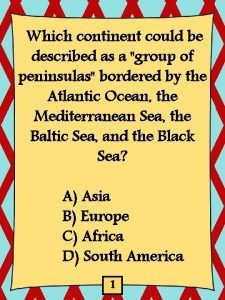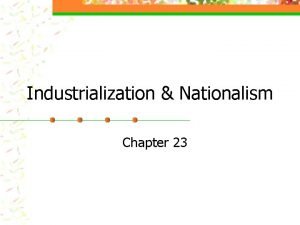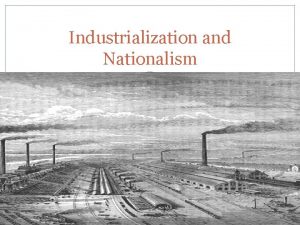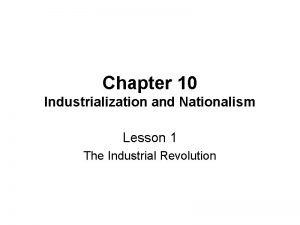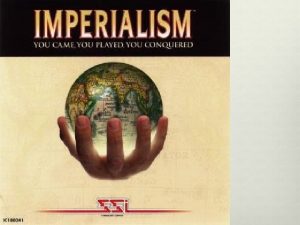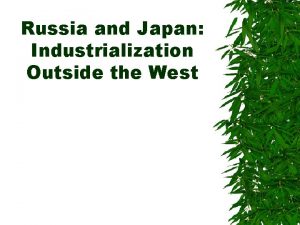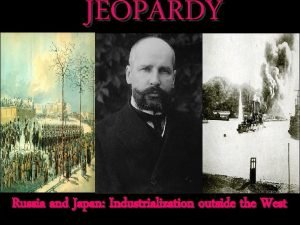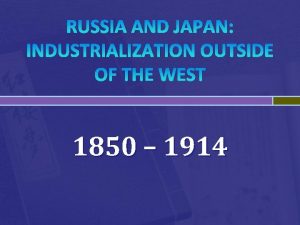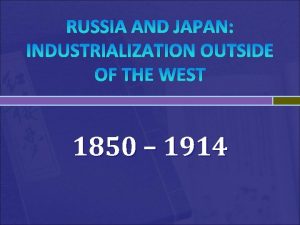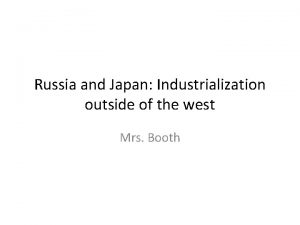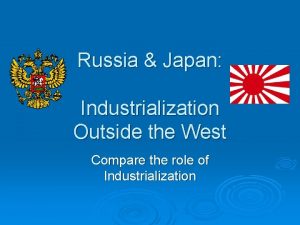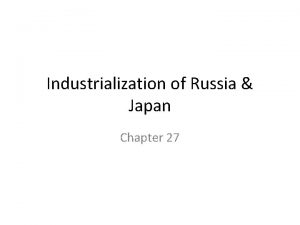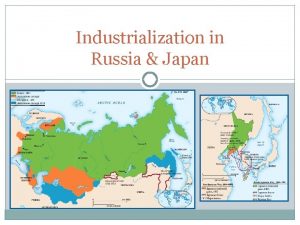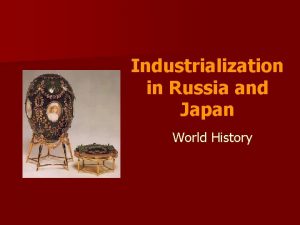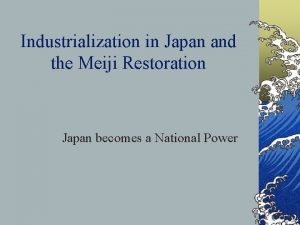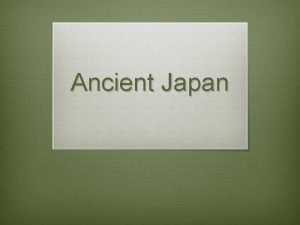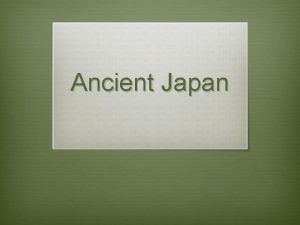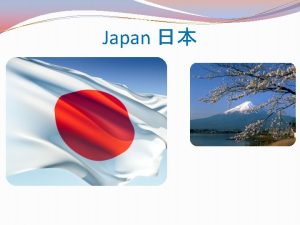Russia and Japan Industrialization Outside of the West








































- Slides: 40

Russia and Japan: Industrialization Outside of the West

Introduction • By the 19 th century Russia and Japan had managed to launch industrialization programs and strengthened their social and political systems. – They were the only countries outside of the West that industrialized before 1960 • Both maintained economic and political independence

Russia’s Reforms and Industrial Advance I. Russia Before Reforms • Anti-Westernization began under the reign of Catherine the Great – Napoleon’s invasion of 1812 • • Conservative intellectuals support isolation Serfdom still exists Improvements in bureaucratic training Alexander I – Forms Holy Alliance with Prussia and Austria to defend religion and established order

Russia’s Reforms and Industrial Advance • Western artistic style was welcomed by the ruling elite – Russia contributes to the cultural movement • Decembrist Revolt • Political revolt in 1825 advocating western type reforms – Put down by Tsar Nicolas I • Secret police expand • Schools and newspapers tightly supervised

Russia’s Reforms and Industrial Advance • Russia avoids a revolution from 1830 -1848 due to political repression • Russia remains conservative • Territorial expansion – Poland • Congress of Vienna of 1815 – Ottoman Empire • Russia supports Balkan independence • France and Britain support Ottomans


Russia’s Reforms and Industrial Advance II. Economic and Social Problems • Russia falls behind the West in terms of industrialization & trade • Russia increases their exports by tightening labor obligations of the peasants • Russia remains an agricultural society – Based on serf labor

Russia’s Reforms and Industrial Advance • Crimean War (1854 – 1856) – Nicholas I provokes conflict with Ottomans in 1853 arguing Russia was responsible for protecting Christianity – France and Britain aid Ottomans • Britain worried about threat to their holdings in India • France sought diplomatic glory and believed they were the defenders of Christianity • The West wins due to their advanced technology

Russia’s Reforms and Industrial Advance • After the war Russia’s new Tsar Alexander II turns to industrialization • Reforms essential to economic growth

Russia’s Reforms and Industrial Advance III. The Reform Era and Early Industrialization • Emancipation of the serfs in 1861 – Aristocrats retained part of their land, but the serfs were given most of it – Serfs obtained no political rights – Tied to land until they could pay for it • Redemption payments went to aristocrats to preserve their class


Russia’s Reforms and Industrial Advance • Emancipation brought about a new urban labor force • Agricultural productivity remained stagnant • Alexander II introduces more reforms in the 1860’s and 1870’s – Zemstvoes – local political councils created – Military reforms – Educational reforms

Russia’s Reforms and Industrial Advance • Industrialization – Trans-Siberian Railroad • Stimulates Russian exports of grain – Factories open building an urban working class • Count Sergei Witte – Minister of finance – Enacted high tariffs – Improved banking systems – Encouraged western investments

Trans-Siberian Railroad

Protest and Revolution in Russia I. The Road to Revolution • Alexander II’s reform & economic change encouraged minority nationalities to make demands – Nationalism was divisive for minorities – Russian nationalists mainstreamed the superiority of Russian tradition

Protest and Revolution in Russia • Social protest over reforms, famines, redemption payments, and taxes • Intelligentsia (Russian intellectuals as a class) became active in arguing for liberal reforms – Wanted political freedom – Wanted to keep Russian culture different from the West • Some seen as radicals and many became anarchists

Protest and Revolution in Russia • Anarchists wanted to abolish all formal government – First large terrorist movement – Assassinations and bombings • Anarchists try to gain peasant support, but fail • Alexander II pulls back from reforms and tightens tsarist control – Censors newspapers and political meetings • Alexander II assassinated by terrorists in 1881

Protest and Revolution in Russia • By the 1890’s protest gained new force • Marxist Socialism spread • Vladimir Ilyich Ulyanov aka Lenin – Argued that because of international capitalism that a proletariat was developing – Political revolution could occur without going through a distinct middle-class phase. – Bolsheviks Communists backed Lenin

Protest and Revolution in Russia II. The Revolution of 1905 • Expansion continues • New Slavic states form in the Balkans – Causes nationalism among Slavs • Serbia • Bulgaria • The trans-Siberian railroad allows Russia to push into Manchuria and obtain long-term leases to Chinese territory

Protest and Revolution in Russia • Russo-Japanese War 1904 -1905 – Caused by Russia’s overextension – Japan worried about Russia pushing farther into China near Korea – Japan wins and moves into Korea

Protest and Revolution in Russia • Russian Revolution breaks out in 1905 – Urban workers go on strike for political gains – Peasant insurrections – Agitated liberals • Police brutality infuriates crowds causing more problems • Duma – National parliament created by liberals – Stolypin reforms

Protest and Revolution in Russia • Tsar Nicholas II strips the duma of power and police repression resumes • Russian government focuses on the Ottoman Empire and being an ally to the Balkan states

Protest and Revolution in Russia III. Russia and Eastern Europe • Russian patterns were paralleled in smaller Eastern European countries • Most new nations established parliaments, but restricted their power • Some became monarchies • Serfdom is abolished

Protest and Revolution in Russia • Cultural productivity helps create a sense of Slavic & Russian heritage – Tchaikovsky – Chopin • Scientific gains – Gregor Mendel – Ivan Pavlov

Japan: Transformation Without Revolution • Western pressure forced Japan to consider reforms in the 1850’s • They combined existing strengths and conditions with significant reforms

Japan: Transformation Without Revolution I. The Final Decades of the Shogunate • Tokugawa Shogunate still in power – Allies with samurai and daiymos • Culture thrives under the Tokugawa • Terakoya schools – Teach Neo-Confuciansims • Dutch studies • Ban of western books ended in 1720

Japan: Transformation Without Revolution • Commerce expanded and monopolies form – Silk – Soy sauce • By the 1850’s economic growth slows – Technological limitations on agriculture expansion and population increase • Rural riots

Japan: Transformation Without Revolution II. The Challenge to Isolation • Commodore Matthew Perry – American who forces Japan to open ports for trade in 1853 • Shogunate Bureaucrats – Some reluctant to open doors to Westerners – Other want to end isolation

Japan: Transformation Without Revolution • 1860’s Civil War breaks out • Samurai attack foreigners • Meiji restoration – Emperor Meutsuhito (Meiji)

Japan: Transformation Without Revolution III. Industrial & Political Change under the Meiji • Meiji government abolishes feudalism – Daimyos replaced with prefects in 1871 • The state centralized and expanded • Samurai sent abroad to study and promote change – Western Europe and US • 1868 -1873 Samurai class is abolished – Some find new roles – Iwasaki Yataro established the Mitsubishi Company

Emperor Meiji

Japan: Transformation Without Revolution • Political reconstruction in the 1880’s • British-style Parliament – House of Peers – upper house – Diet – lower house • Constitution of 1889 • Emperor command the military

Japan: Transformation Without Revolution IV. Japan’s Industrial Revolution • Westernization of: – Military – Banks – Railroads – Steam ships – Agricultural methods

Japan: Transformation Without Revolution • New Economic structure depended on the removal of tariffs and guilds • Land reforms – Allows individuals to own land • Ministry of Industry created in 1870 – Set overall economic policy – Operated specific sectors of government – Establishes model factories, shipyards, and arsenals

Japan: Transformation Without Revolution • By 1900 the Japanese economy was fully launched by industrial revolution – Private enterprise – Careful management of foreign advice – Dependent on exports to pay for needed imports

Japan: Transformation Without Revolution • The Industrial Revolution, manufacturing, commercial agriculture, and political change had significant ramifications with Japanese Culture and Society – Massive pop. Growth – Reduction of death rates • Pop growth strained Japan’s resources • Ensured low-cost labor

Japan: Transformation Without Revolution • Japan’s government introduced a universal education system • Western fashions copied • Western standards of hygiene • Shintoism grew – few converted to Christianity – Buddhism loses ground • Traditional family life – Divorce introduced

Japan: Transformation Without Revolution • Economic changes – Change in foreign policies – Imperialism – Territorial expansion • Need raw materials • Sino-Japanese War • China vs Japan • Japan wins, but Western pressure forces them to withdraw from the Liaodong Peninsula


Japan: Transformation Without Revolution V. The Strain of Modernization • Disputes between young and old over Westernization • Political Parties clash – Diet dissolves • Nationalism & repression allow Japan to avoid Revolutionary pressure
 Which number on the map represents the english channel?
Which number on the map represents the english channel? East is east and west is west
East is east and west is west Horizontal movement of air is called
Horizontal movement of air is called What creates wind
What creates wind Oost noord zuid west
Oost noord zuid west Old west vs new west
Old west vs new west Revolution
Revolution Lesson quiz 10-2 industrialization and nationalism answers
Lesson quiz 10-2 industrialization and nationalism answers -have strength to match the growth of industrialization
-have strength to match the growth of industrialization Chapter 10 lesson 1 the industrial revolution
Chapter 10 lesson 1 the industrial revolution Under imperialism the stronger nation attempts to
Under imperialism the stronger nation attempts to Industrial revolution social darwinism
Industrial revolution social darwinism Hát kết hợp bộ gõ cơ thể
Hát kết hợp bộ gõ cơ thể Slidetodoc
Slidetodoc Bổ thể
Bổ thể Tỉ lệ cơ thể trẻ em
Tỉ lệ cơ thể trẻ em Chó sói
Chó sói Tư thế worm breton là gì
Tư thế worm breton là gì Chúa yêu trần thế
Chúa yêu trần thế Các môn thể thao bắt đầu bằng tiếng nhảy
Các môn thể thao bắt đầu bằng tiếng nhảy Thế nào là hệ số cao nhất
Thế nào là hệ số cao nhất Các châu lục và đại dương trên thế giới
Các châu lục và đại dương trên thế giới Cong thức tính động năng
Cong thức tính động năng Trời xanh đây là của chúng ta thể thơ
Trời xanh đây là của chúng ta thể thơ Mật thư tọa độ 5x5
Mật thư tọa độ 5x5 101012 bằng
101012 bằng Phản ứng thế ankan
Phản ứng thế ankan Các châu lục và đại dương trên thế giới
Các châu lục và đại dương trên thế giới Thơ thất ngôn tứ tuyệt đường luật
Thơ thất ngôn tứ tuyệt đường luật Quá trình desamine hóa có thể tạo ra
Quá trình desamine hóa có thể tạo ra Một số thể thơ truyền thống
Một số thể thơ truyền thống Cái miệng bé xinh thế chỉ nói điều hay thôi
Cái miệng bé xinh thế chỉ nói điều hay thôi Vẽ hình chiếu vuông góc của vật thể sau
Vẽ hình chiếu vuông góc của vật thể sau Thế nào là sự mỏi cơ
Thế nào là sự mỏi cơ đặc điểm cơ thể của người tối cổ
đặc điểm cơ thể của người tối cổ V cc
V cc Vẽ hình chiếu đứng bằng cạnh của vật thể
Vẽ hình chiếu đứng bằng cạnh của vật thể Tia chieu sa te
Tia chieu sa te Thẻ vin
Thẻ vin đại từ thay thế
đại từ thay thế điện thế nghỉ
điện thế nghỉ
